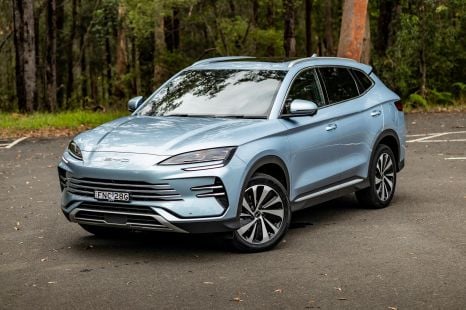

Josh Nevett
CarExpert's top five mid-size SUV reviews of 2025
52 Minutes Ago
It's certainly not the roomiest small SUV, but the Hyundai Kona has a lot to offer in this competitive segment.
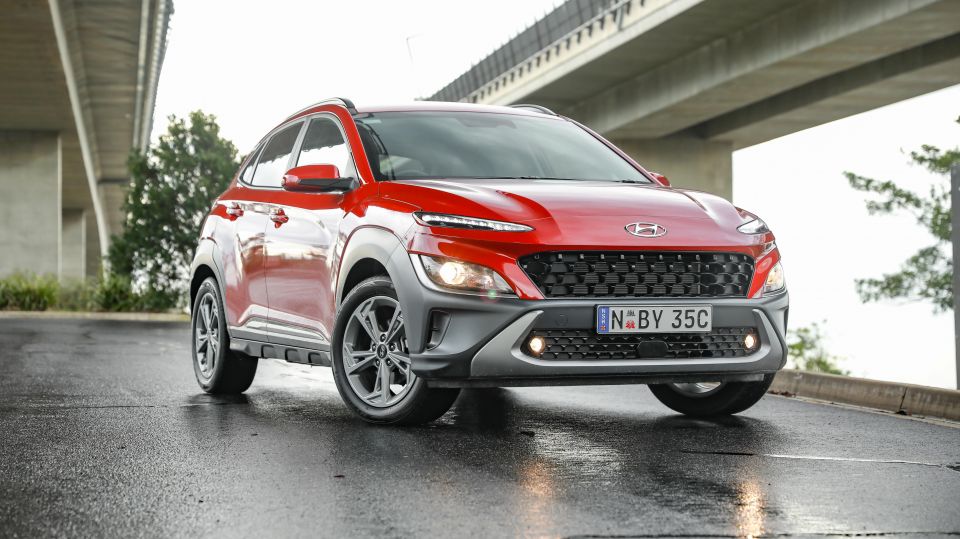


News Editor
New from
$31,600
excl. on-roads

News Editor
New from
$31,600
excl. on-roads


News Editor
New from
$31,600
excl. on-roads

News Editor
New from
$31,600
excl. on-roads
Quickly see how this car stacks up against its competition. Select any benchmark to see more details.
Where expert car reviews meet expert car buying – CarExpert gives you trusted advice, personalised service and real savings on your next new car.
For a little while, it looked like the Hyundai Kona was finally going to take over from the Mitsubishi ASX as Australia’s best-selling small SUV.
That was until the MG ZS family took the lead, with the Kona currently sitting in second place through the end of June.
That just goes to show how under-fire established competitors like the Kona are from Chinese insurgents like the ZST and the new Haval Jolion.

The Koreans may no longer be the cheapest in this segment, but the Kona still has a lot to offer. It’s also received a mid-life freshening that, though raising the price, has increased the list of standard equipment.
There’s tweaked styling, improved infotainment and more sophisticated safety technology, while the base engine has a new transmission that promises improved fuel economy.
That leaves us with two questions: are these improvements enough to put the Kona at the top of the segment sales charts, and should it be at the top of your shortlist?

The 2021 Hyundai Kona range opens at $26,600 before on-road costs for the unnamed base model. Our tester is the mid-range Kona Elite, priced at $31,600 before on-road costs.
Premium paint is an extra $595, with Arctic White the standard colour on the Kona Elite. Ours was finished in Pulse Red, while other shades include Dark Knight, Phantom Black, Surfy Blue and my personal favourite, Dive In Jeju, a vibrant blue.
As tested, our car therefore cost $32,195 before on-roads or $35,968 drive-away based on a Sydney postcode.
A comparably-specified Kia Seltos in Sport+ trim is pricier on paper at $33,290 before on-roads but Kia’s usually sharper nationwide drive-away pricing allows it to slide under the Kona at $35,855 drive-away with premium paint.
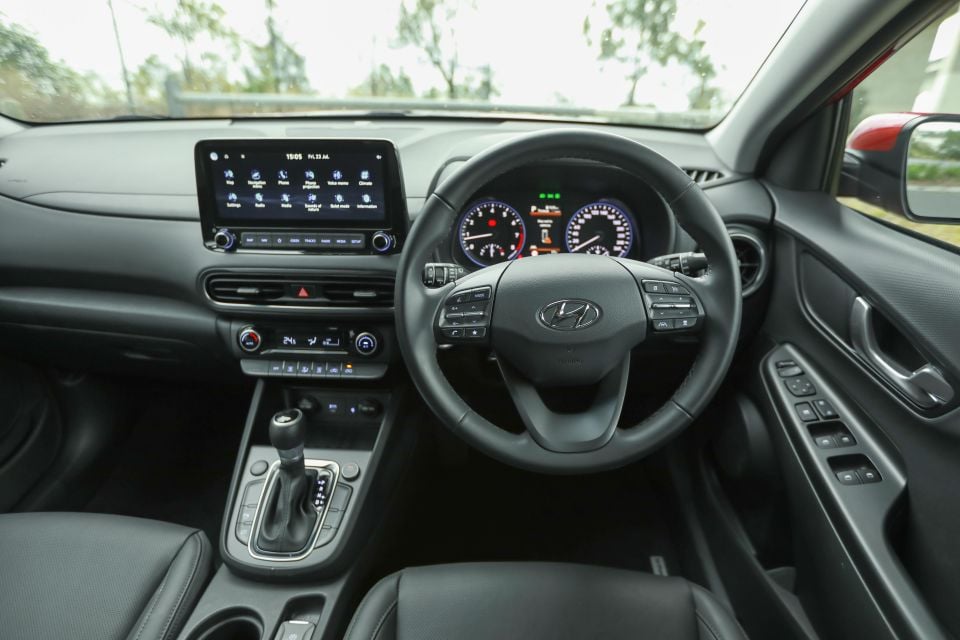
Considering the Kona isn’t any more spacious than some so-called ‘light SUV’ offerings (more on that later), there’s a large spread of rivals for the little Hyundai.
These include:
All prices exclude on-road costs unless specified (d/a)
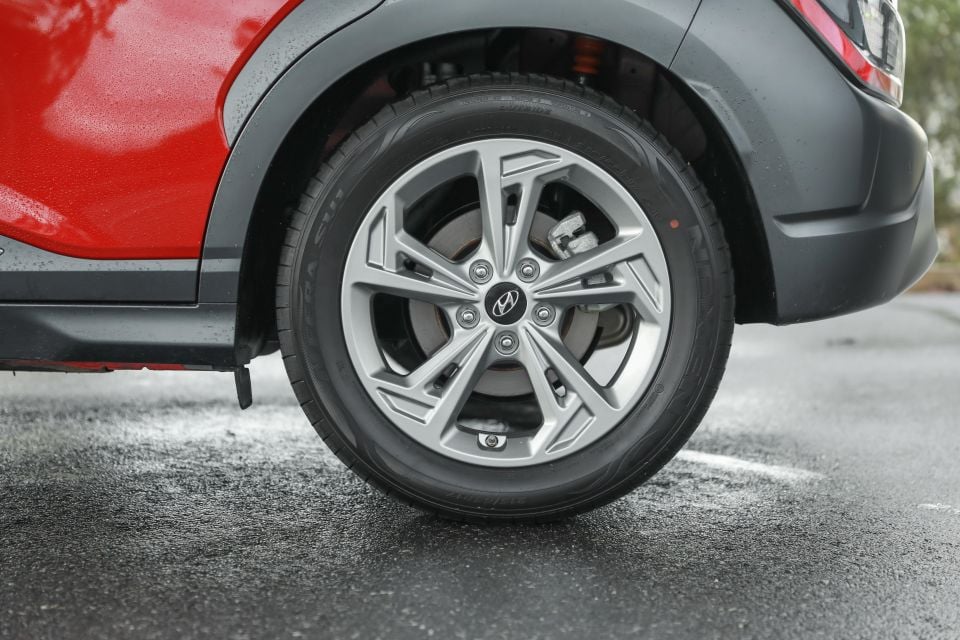
Buy your new car without the stress. It's fast, simple and completely free.

Great service from Travis and team, second time I have used this business would not hesitate to recommend them to anyone
Craig C.
Purchased a Ford Ranger in Sunshine Coast, QLD
CarExpert helped Craig save thousands on his Ford Ranger, now let us save you on your next new car.
Find a dealThough the Elite costs $2600 more than the Active, it adds some key comfort and convenience features plus extra safety kit (more on that later). This includes:
That’s over the Active’s standard equipment list, which includes:
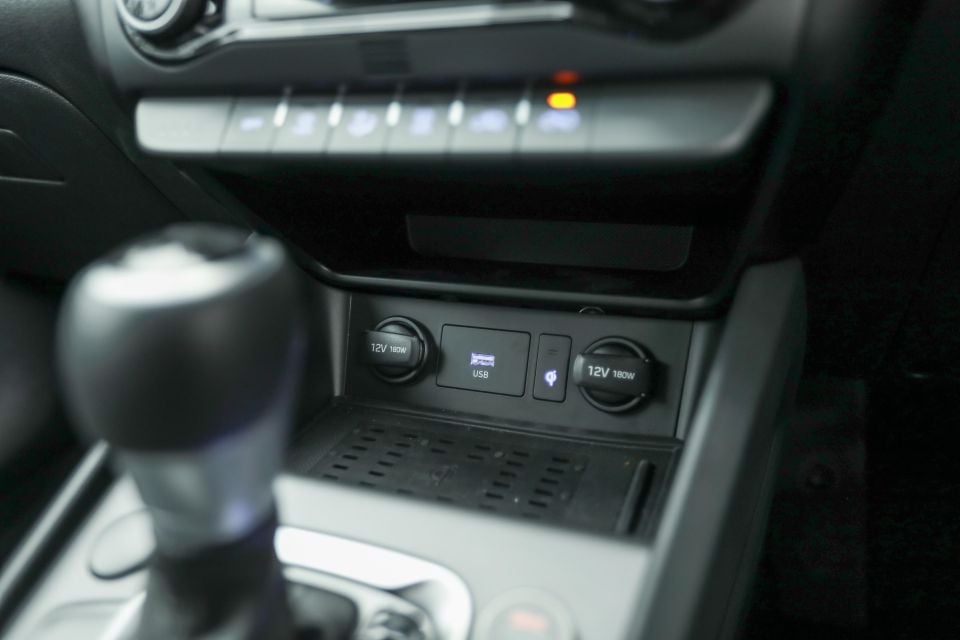
All Kona models also come standard with Qi wireless phone charging, tyre pressure monitoring, automatic halogen projector-type headlights, a reversing camera, and LED daytime running lights.
The Elite’s equipment list largely aligns with that of the i30 Elite, though the Kona has only single- instead of dual-zone climate control. The Kona counters with remote start as well as active blind-spot and rear cross-traffic assists. Compared to the Seltos Sport+, the Kona Elite misses out on front parking sensors but has two extra speakers.
You can get luxury features like a head-up display, panoramic sunroof and a power driver’s seat in a Jolion Ultra, while a Kamiq Ambition has niceties like a digital instrument cluster and a power tailgate.
Compared with the broader competitive set, however, the Kona Elite’s equipment level stacks up well, and we feel there’s enough of a reason to step up from the Active. Spending the extra $6400 over this to get the Highlander, however, is less of a no-brainer.

When the Hyundai Kona was tested by ANCAP in 2017, it received a rating of five stars.
That rating was based on a frontal offset score of 14.07 out of 16 and a side impact score of 16 out of 16. Whiplash and pedestrian protection were rated Good and Acceptable, respectively.
All Kona models come standard with the following safety equipment:
Stepping up to the Elite adds more safety equipment, including:
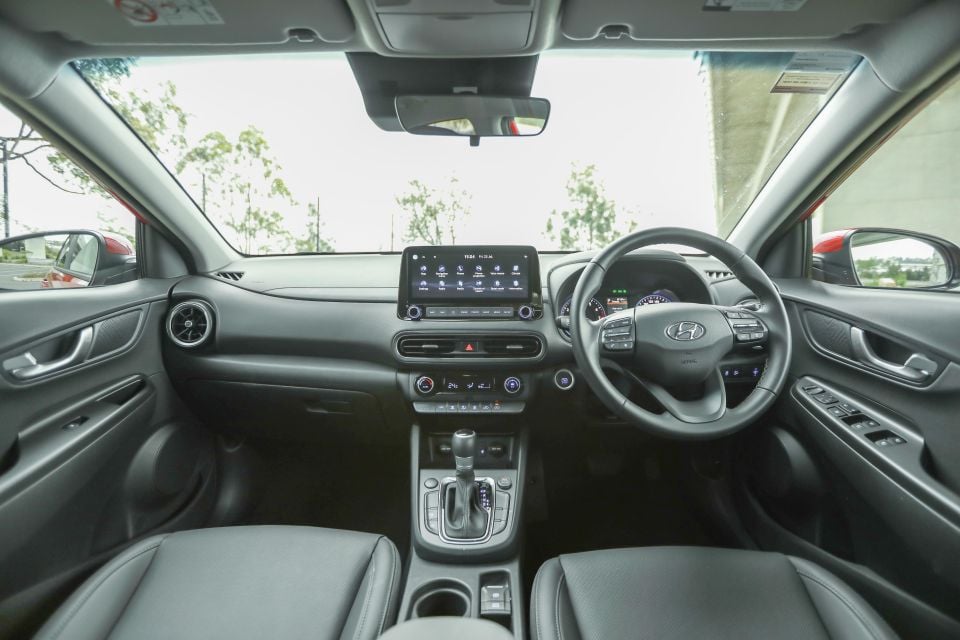
It’s rather remarkable that the Hyundai Motor Group can simultaneously offer perhaps the best-packaged and the worst-packaged models in a single segment.
Where the Kia Seltos can make you wonder why a mid-sized SUV is necessary, the Kona will have you wondering why it’s priced at a premium over an i30 hatchback. The Kona’s wheelbase is 50mm shorter than that of an i30 hatchback, as its tight rear-seat accommodations will attest.
Someone measuring 180cm can sit behind a similarly tall front-seat occupant with just enough legroom, toe room and head room but it does feel a little confining, particularly as you’ll have to watch your head stepping into the back seat.
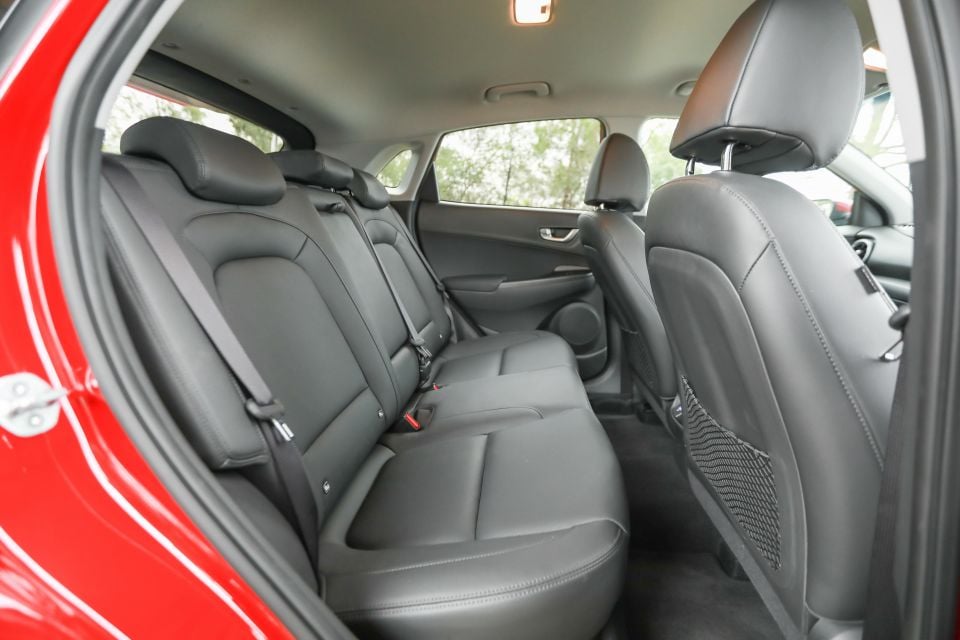

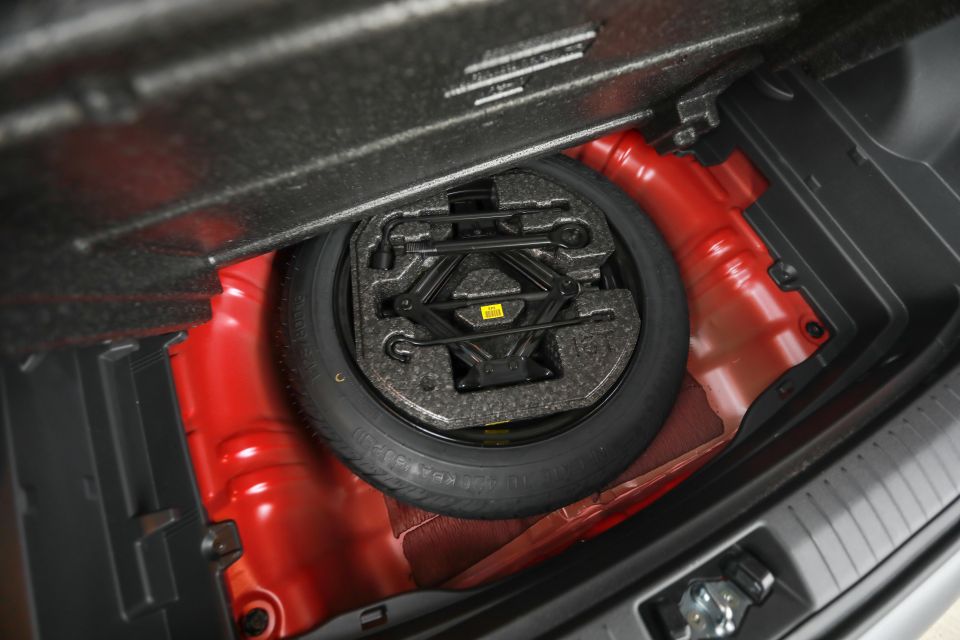
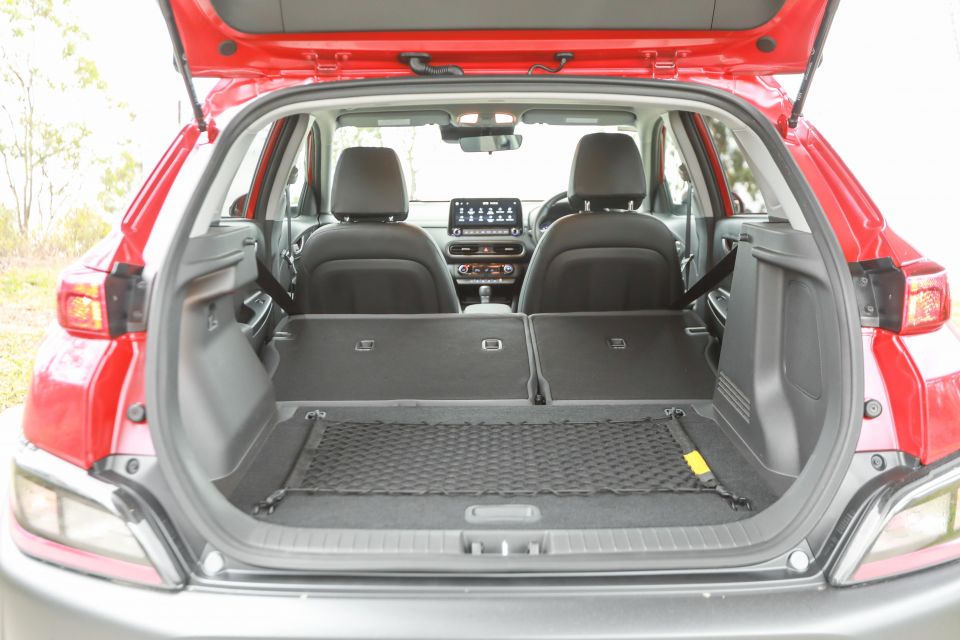
There are no air vents back here, either, and only a lone USB-A point. If you’re only carrying small children, there are three top-tether and two ISOFIX anchor points for child seats. A Seltos has a much more hospitable back seat for all occupants, regardless of age.
Luggage space is 374L per the VDA standard, increasing to 1156L with the rear seats folded. Again, that’s less space than an i30 Hatch (395/1301L) or a Seltos (433/1393L). It’s also less than so-called light SUVs like the Juke (422L/1305L) and Puma (410L/1170L).
Step into the front and the Kona is more likely to delight with its attractive, logically laid-out dashboard. Everything falls neatly to hand, from the intuitive cruise control switches on the steering wheel to the hard shortcut buttons below the touchscreen.
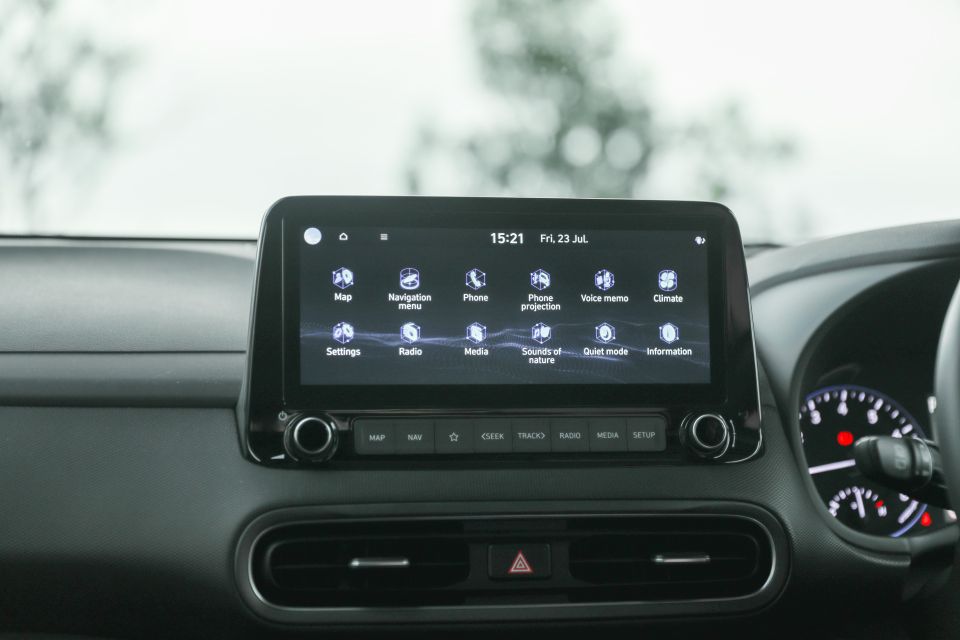
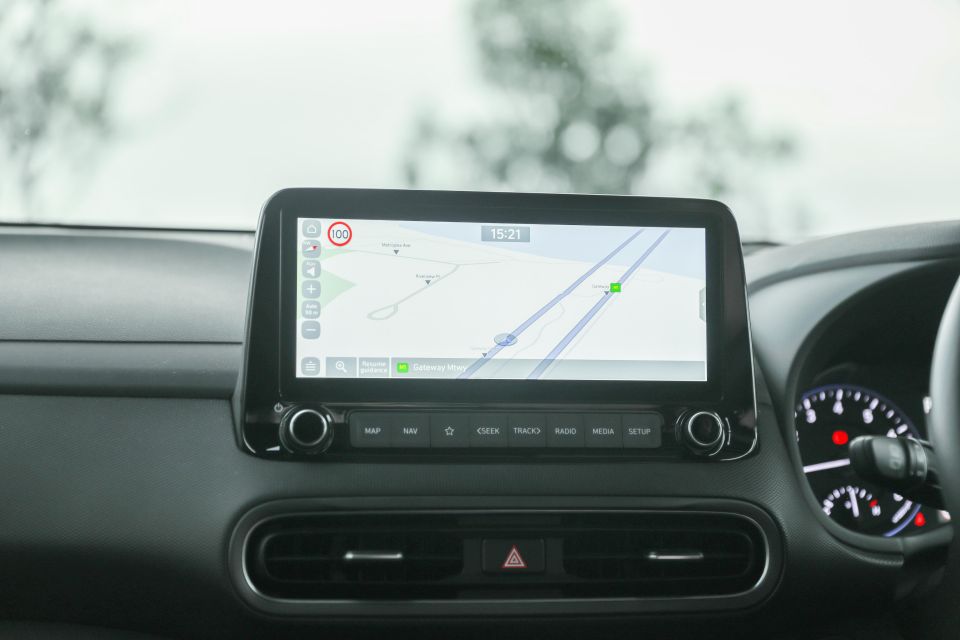
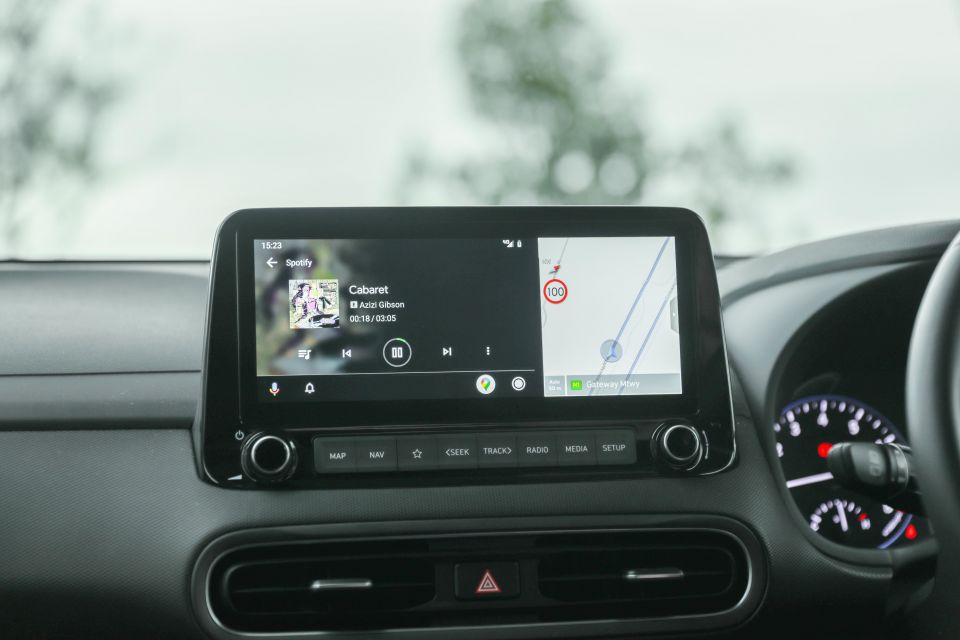
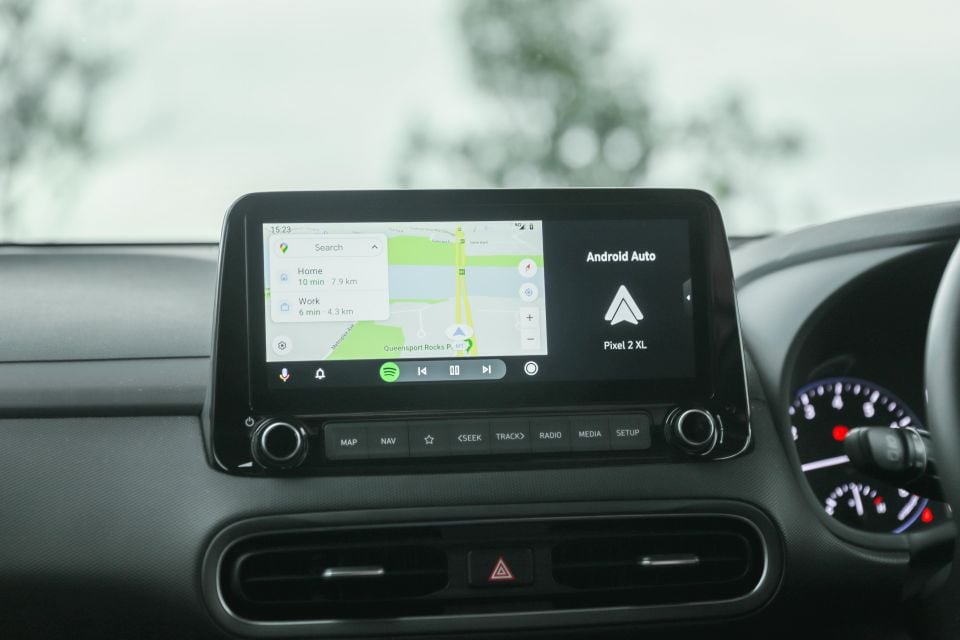
That touchscreen, measuring 10.25 inches, is one of the largest in the segment. As expected from a Hyundai product, it boasts quick response times and neat graphics. There are also neat features like Sounds of Nature, a voice memo function, and a quiet mode.
One thing it misses out on, but which is available with the smaller 8.0-inch screen in base and Active models, is wireless Android Auto and Apple CarPlay. The flipside to that is it gets factory satellite navigation.
Unfortunately, the Hyundai Motor Group is still locked in a stalemate with an unspecified tech giant which apparently doesn’t want the factory navigation function to be the default map for the system.
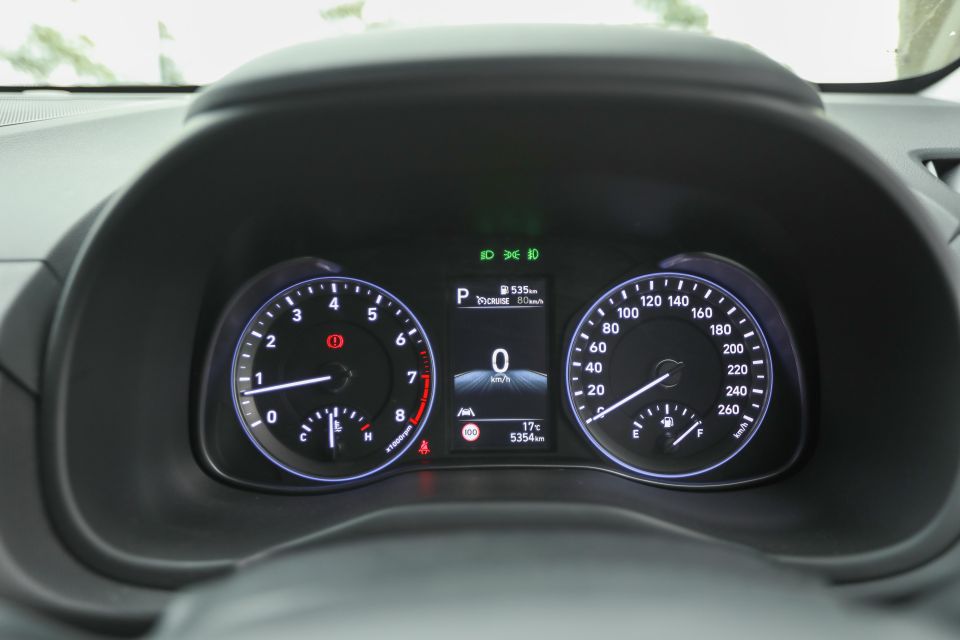
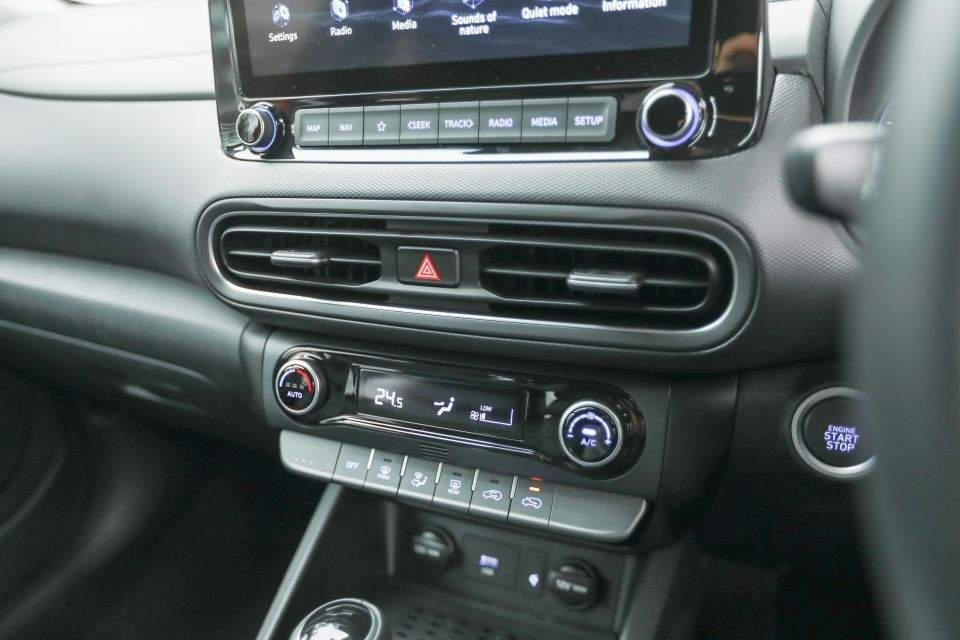

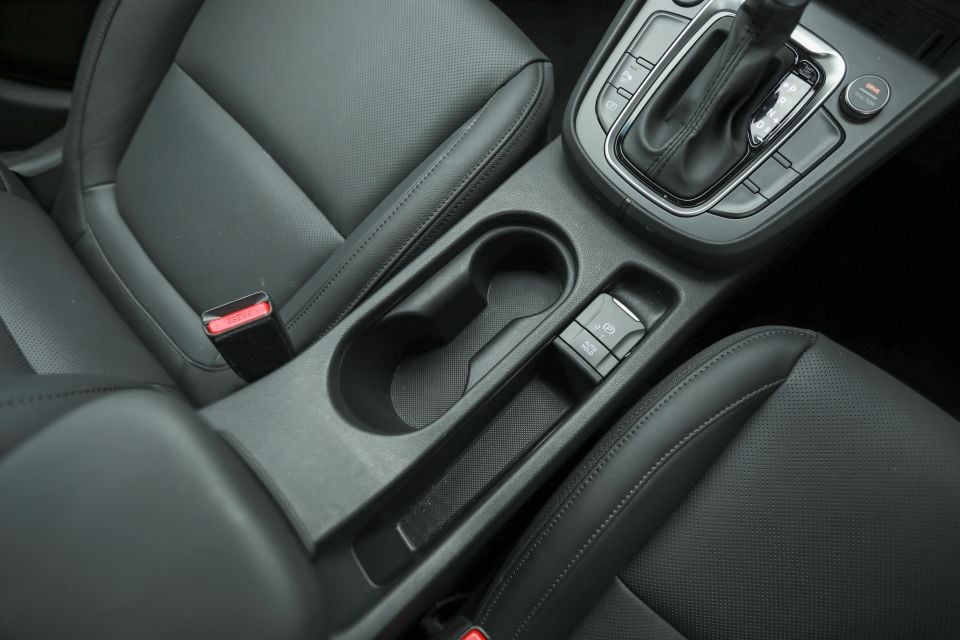
The analogue instruments are neat and legible and, like most everything in this cabin, feature soft blue backlighting.
There’s a colour 4.2-inch information screen in between the analogue dials. While the instruments aren’t as futuristic as the digital cluster available in up-spec Kona models, they look more harmoniously integrated.
The use of materials in the Kona is a bit puzzling. There’s this dimpled, soft-touch material across the front of the dashboard, for example, but the dimpled material on the tops of the doors is rock-hard.
The top of the dash is also hard, but there’s soft leatherette on the door cards. It’s all functional, though and there’s enough of the soft-touch stuff to improve the ambience.
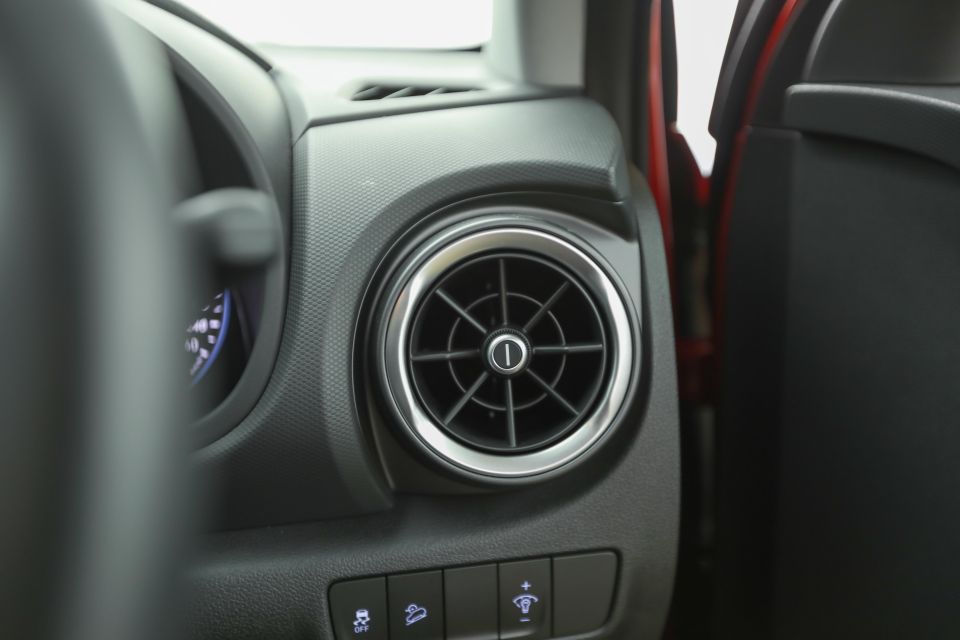
The circular air vents on either end of the dashboard add a dash of style to the interior, which otherwise follows the traditional, handsome interior design language of most Hyundai products.
The only material we feel needs to be changed is the base of the centre console bin, which lacks any kind of rubberised or felt pad to stop objects from noisily rolling around.
Regardless of how tactile the interior is, it’s screwed together well. And though there’s liberal use of hard plastics, as with many other small SUVs, even these more rigid materials are attractive.
We didn’t encounter any rattles or squeaks during our time with it, with the only interior glitch being a seatbelt sensor that didn’t detect when a rear-seat occupant was unbuckled.
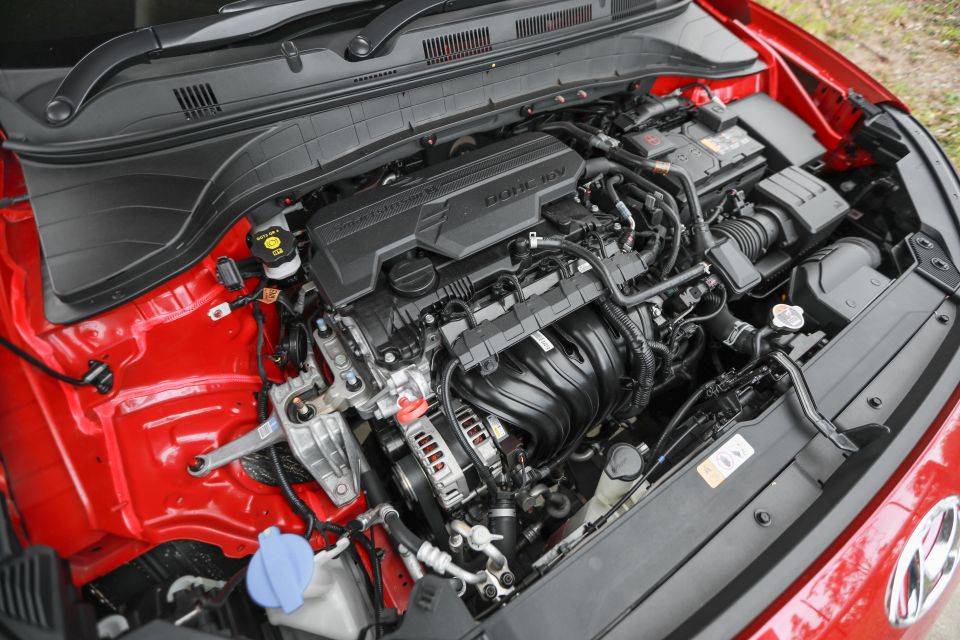
The Kona Elite is powered by a naturally-aspirated 2.0-litre four-cylinder petrol engine producing 110kW of power and 180Nm of torque. It’s mated to a continuously-variable transmission and front-wheel drive.
The CVT replaces the six-speed torque-converter automatic used in the pre-update model. Fuel economy has commensurately improved, from 7.2L/100km on the combined cycle to 6.2L/100km. It runs on 91 RON regular unleaded fuel.
Over a mix of inner-city, suburban and highway driving, we averaged 7.4L/100km, while our cumulative total was 7.8L/100km.
While the pre-update Kona offered a turbocharged 1.6-litre four-cylinder option with all-wheel drive across the range, the 2021 model limits this to the sporty new N Line and N Line Premium variants.
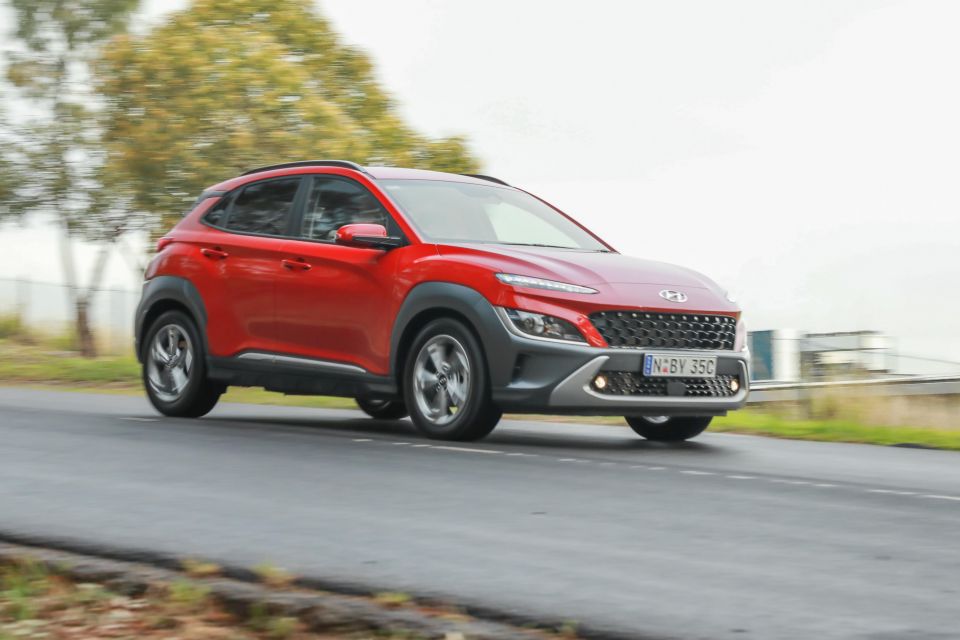
Where expert car reviews meet expert car buying – CarExpert gives you trusted advice, personalised service and real savings on your next new car.
Switching to a CVT was a wise choice by Hyundai.
Within the Hyundai Motor Group family, vehicles with a naturally-aspirated 2.0-litre four and a CVT seem to be consistently better to drive than the same engine with a torque-converter automatic.
While a Kia Cerato or a Hyundai Tucson feels slow and sometimes thrashy, the Kona – like its Kia Seltos cousin – feels perennially peppy. Hyundai has nailed its CVT calibration, avoiding the droning sound and rubber-band feeling of other transmissions of this breed. There’s a Sport mode that’ll adjust the throttle response, but we didn’t see the point.
You virtually never have to work the Kona very hard to get the most out of it, which means you’ll never really hear it get noisy.
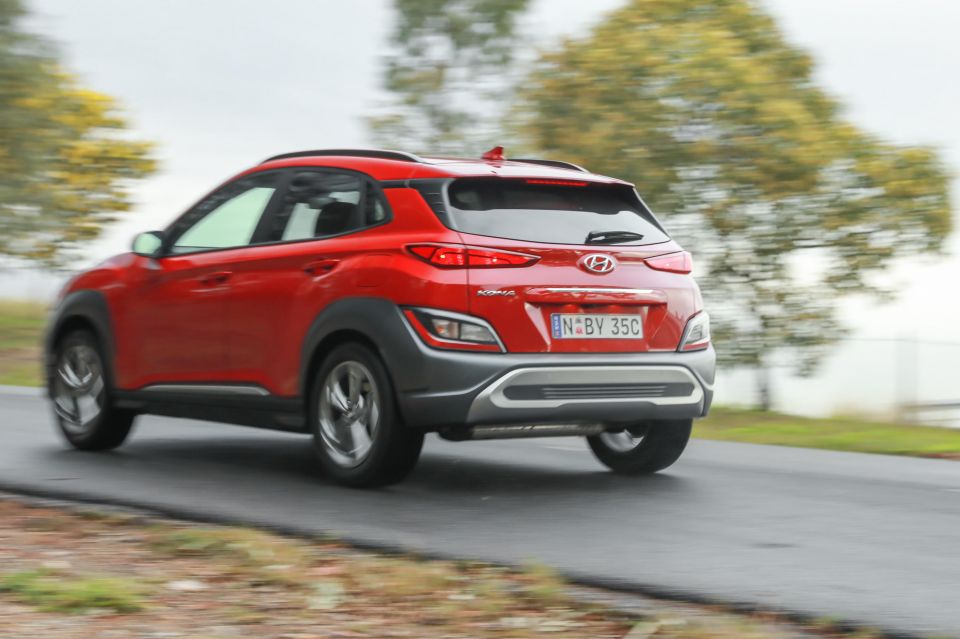
It’s other noise you’ll have to contend with in the Kona. At highway speeds, wind noise is noticeable, while there’s a good deal of tyre roar on coarse-chip roads. We wouldn’t call the Kona noisy, per se, but there’s still a little work Hyundai could do to make the cabin more serene.
The Kona doesn’t look much higher off the ground than a regular hatch, nor does it feel it inside. So, it comes as no surprise it doesn’t feel terribly different to an i30 Hatch to drive.
You can feel the centre of gravity is a bit higher and there’s a tad more body roll in corners, but the Kona is still one of the most car-like crossovers to drive. That makes it one of the more fun-to-drive cars in this segment, with keen and direct handling. The steering is a bit light on centre but is otherwise fluid and loads up nicely in corners.
The trade-off of handling that’s more nimble than rivals is the ride is a bit on the firmer side. The suspension tuning means it can feel terse at times, but it ultimately absorbs larger bumps quite well.
We usually rate Hyundai’s lane-keep assist systems. It’s almost expected they’ll be a little interventionist but ultimately keep you within your lane. Well, the Kona’s system needs some recalibration as it had a serious case of the wobbles.
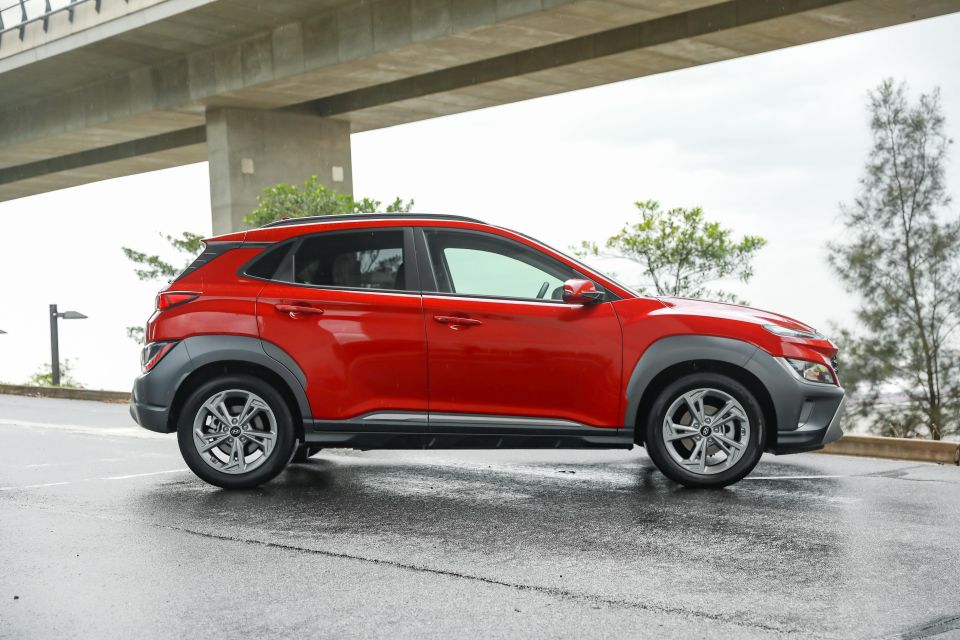
On even the most typical of roads with no confusing lane markings, the steering wheel would visibly squirm in your hands from side to side.
The Kona has easily the worst lane-keep assist calibration of any Hyundai Motor Group product I’ve driven and this issue wasn’t exclusive to our car, with a week behind the wheel of a top-spec N Line Premium demonstrating the same issue applies there, too.
I most assuredly wanted to turn it off each time, and I’m not usually precious about lane systems.
The silver lining is the Lane Following Assist works exceptionally well, as we’ve come to expect from Hyundai Motor Group products. Its preternatural ability to keep you within your lane is impressive, especially considering the price point this technology is available at.
In addition to the typical Eco, Comfort and Sport drive modes, you can use the drive mode dial to select one of three traction modes: Snow, Mud and Sand. These alter the throttle response and traction control but, given the Kona Elite lacks all-wheel drive, we can’t imagine these will be of much use to many punters.
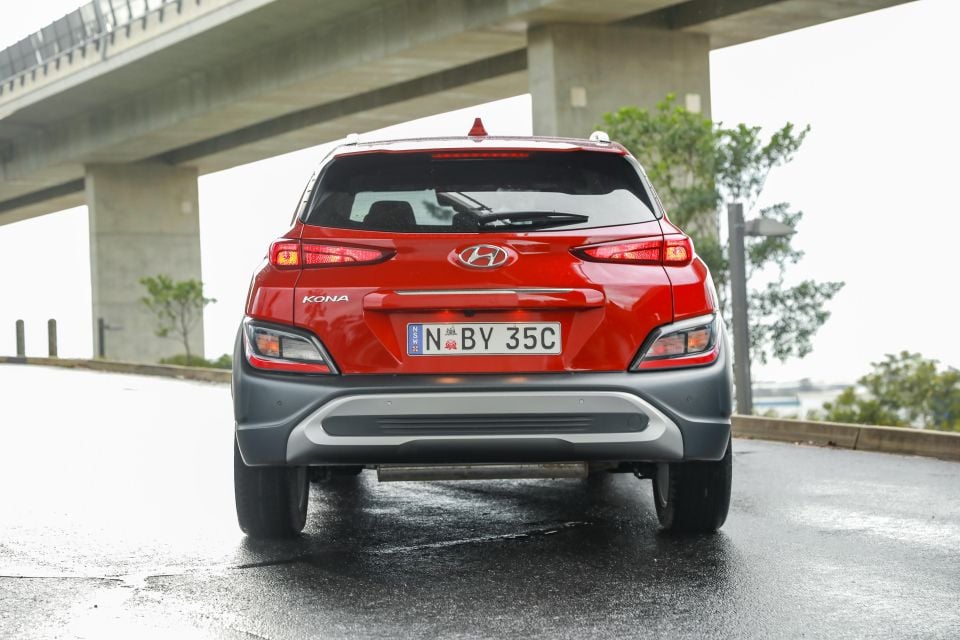
In addition to a five-year, unlimited-kilometre warranty, Hyundai offers capped-price servicing for the Kona.
The first five services are capped at $319 each or $1595 in total, with servicing required every 12 months or 15,000km.
Even beyond the five-year point, service pricing is capped under Hyundai’s Lifetime Service Plan.
Service pricing mightn’t be quite as cheap as Toyota’s, but it’s more consistently priced than Kia’s and it’s essentially identical in cost to the Mazda CX-30 and Mitsubishi Eclipse Cross.
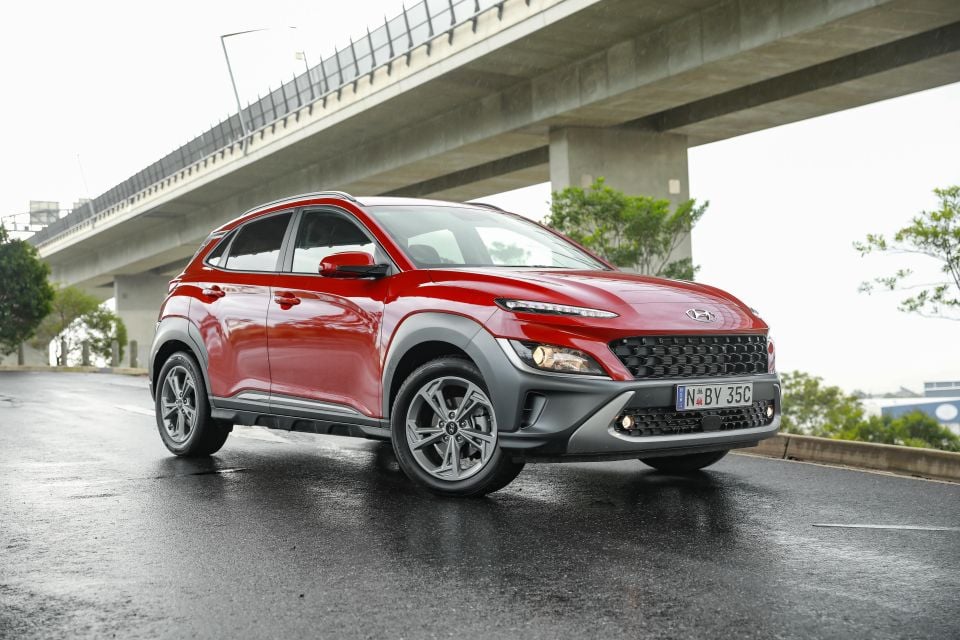
Don’t assume that just because the Hyundai Kona is marketed as an SUV that it’s going to offer oodles more space and versatility than an i30 hatchback. In terms of SUV attributes, you’ll get a slightly higher hip-point, and that’s about it.
That’s not entirely a bad thing. With recent i30 Hatch price increases, the amount of “SUV tax” you’ll pay for the Kona has shrunk to less than $1500.
For that, you unfortunately get a tighter back seat and boot but you get funkier styling, more sophisticated safety technology and a more enjoyable powertrain. Provided your rear-seat occupants are somewhere between babbling and texting in age, that’s not the worst trade-off.
It’s not as roomy as numerous other SUVs at this price point and the Chinese undercut it on price but, these points aside, the Kona has plenty of strengths to tout.
The Kona’s spunky engine, balanced chassis, affordable service pricing, attractive interior and its excellent infotainment all give it more than enough reason to sit on your shortlist.
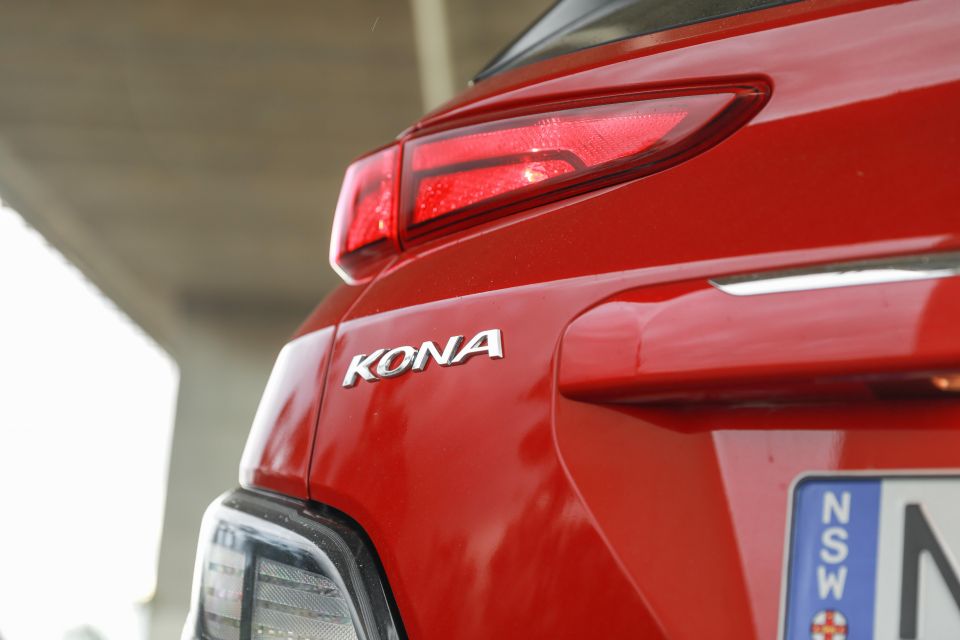
Click the images for the full gallery
MORE: Everything Hyundai Kona
Where expert car reviews meet expert car buying – CarExpert gives you trusted advice, personalised service and real savings on your next new car.
William Stopford is an automotive journalist with a passion for mainstream cars, automotive history and overseas auto markets.


Josh Nevett
52 Minutes Ago


Max Davies
9 Hours Ago


Damion Smy
19 Hours Ago


Ben Zachariah
1 Day Ago
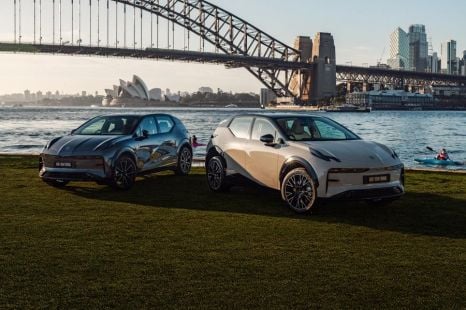

Max Davies
1 Day Ago


Damion Smy
2 Days Ago